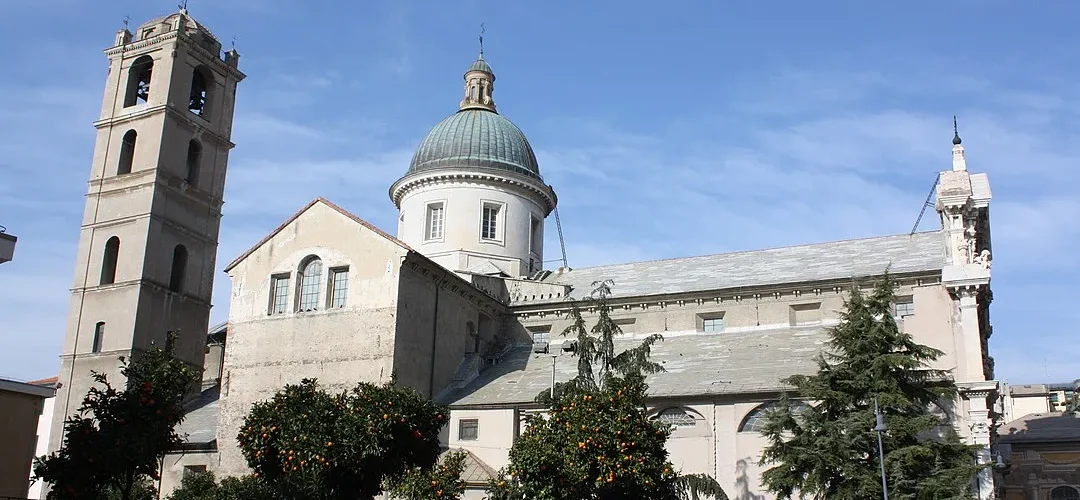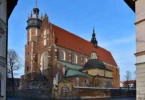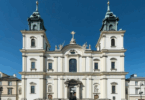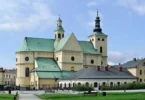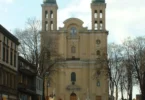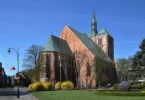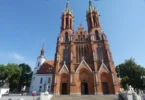Introduction
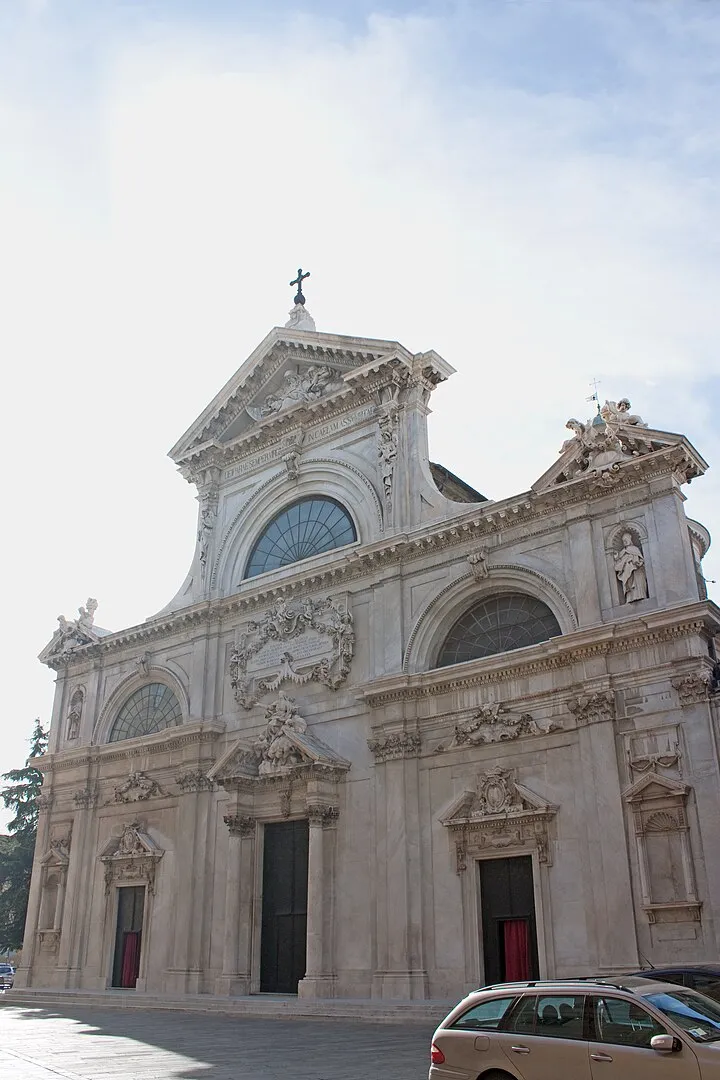
The Savona Cathedral (Italian: Duomo di Savona, Cattedrale dell’Assunta) is a prominent Roman Catholic cathedral located in the heart of Savona, a coastal city in the Liguria region of Italy. Officially known as the Cathedral Basilica of Santa Maria Assunta, the cathedral is dedicated to the Assumption of the Virgin Mary, celebrating her being taken bodily into heaven. Historically, it served as the episcopal seat of the Diocese of Savona, but since 1986, it has been the episcopal seat of the Diocese of Savona-Noli.
This architectural masterpiece stands as the central place of Catholic worship in Savona, acting as the mother church for the diocese. The cathedral is strategically situated in the city’s historic center, in close proximity to several notable landmarks, including the famous Sistine Chapel in the nearby Papal residence. A significant monument of Italy’s national heritage, the Savona Cathedral is recognized as an Italian national monument for its historical, cultural, and religious importance. Its grandeur, artistic features, and spiritual significance make it one of the key symbols of the region’s religious and architectural heritage.
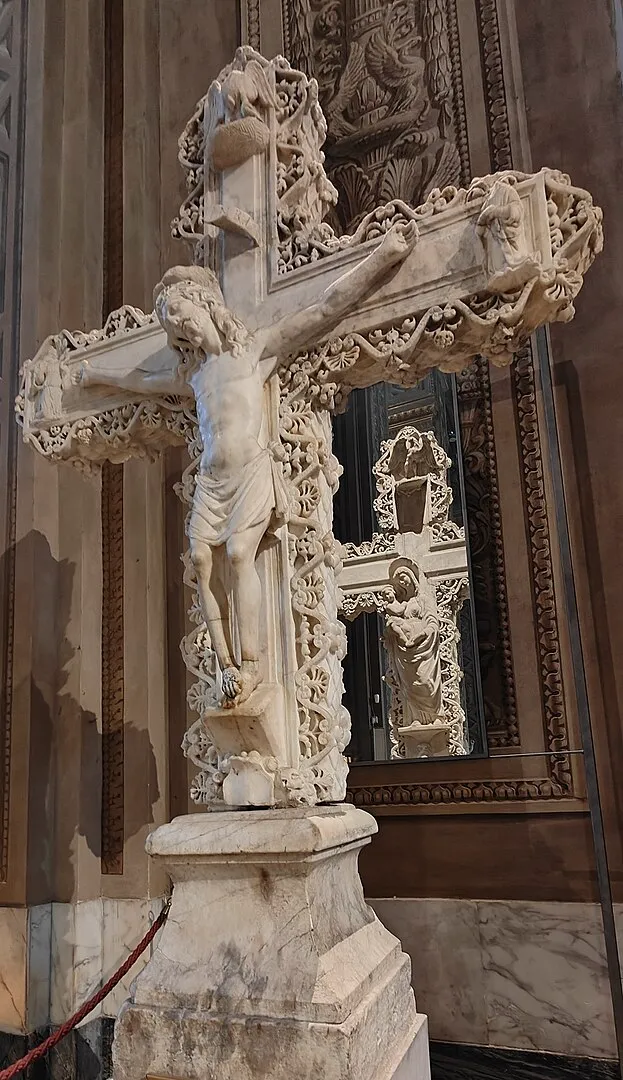
The origins of Savona Cathedral trace back to the 9th century, when an ancient cathedral was first established. Over time, the cathedral became an important religious center in the city. However, significant historical events in the 16th century led to its eventual destruction and the construction of a new structure.
Genoese Occupation and Destruction
In 1528, Savona was surrendered to the Genoese troops, who had successfully conquered the city and subsequently occupied the Priamar hill, which housed the oldest part of the town. Over the following years, the Genoese carried out extensive urban changes, most notably by building a fortress on the site of the ancient cathedral. In the process, they systematically demolished the historic buildings, including the cathedral that had stood since the 9th century. The cathedral was deconsecrated and eventually destroyed in 1595, marking the loss of this significant cultural and religious landmark.
The Role of San Francesco Church
In response to the destruction of the original cathedral, Pope Paul IV made a pivotal decision in 1559, selecting the nearby and older church of San Francesco as the new cathedral for the city. This church, with its accompanying cloister, still stands on the right side of the current cathedral and remains a testament to the city’s historical continuity.
Construction of the New Cathedral
In 1584, the construction of the new cathedral commenced, initially dedicated to San Francesco. The building process continued for several years, and the cathedral was completed in 1605. Over time, the cathedral’s dedication shifted, and it was ultimately consecrated to Nostra Signora Assunta (Our Lady of the Assumption), reflecting the growing religious influence of the Virgin Mary in the region.
Recognition as a Minor Basilica
In June 1816, Savona Cathedral was elevated to the status of a minor basilica by the Vatican, recognizing its religious significance and the role it played in the spiritual life of the community.
Integration into Savona’s Museum Complex
In December 2024, the cathedral and the adjacent Sistine Chapel became part of the newly established museum complex of Savona. This development aims to preserve and showcase the cultural and architectural heritage of the city, ensuring that the cathedral’s history continues to be appreciated by future generations.
Architecture of Cathedral of Our Lady of the Assumption, Savona, Italy
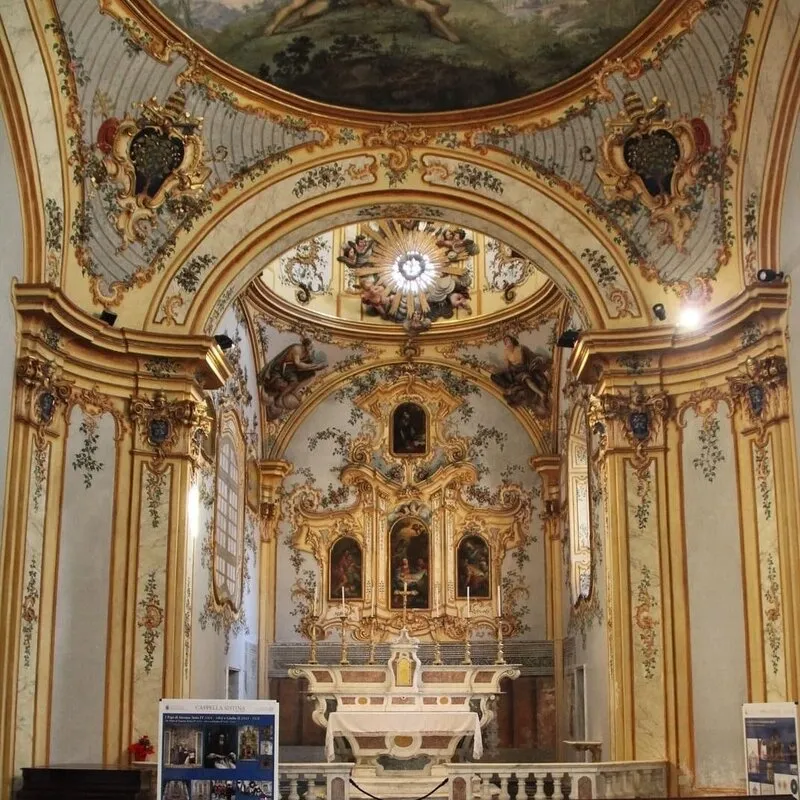
Architectural Styles: Baroque architecture
Architecture
The Savona Cathedral, with its impressive dimensions, spans 61 meters in length and 39 meters in width. Its layout follows a Latin cross plan, featuring three distinct naves. The central nave and the transept are topped with barrel vaults, while the lateral naves are adorned with cross vaults. Above the transept is a dome, crowned with a windowed drum that allows natural light to illuminate the interior. The bell tower, which was only completed in 1929, stands prominently on the right side of the building, enhancing the cathedral’s profile against the skyline.
Facade
The cathedral’s facade is designed in the Neo-Baroque style and was constructed by Guglielmo Calderini between 1881 and 1886. The facade is divided into three vertical sections, each containing a portal, and three horizontal registers that break up the surface into tiers. The external portal, dating back to 1776, was integrated into the facade in the late 19th century. The portal features a depiction of the Assumption of the Virgin Mary, crafted by the abbot Giovanni Antonio Cybei, adding a sculptural focus to the entrance.
Interior
Upon entering the cathedral, visitors are immediately struck by the marble crucifix, likely dating back to the 15th century, with a Madonna and child carved on its reverse side. In December 2022, a mirror was added to this feature to enhance its visual impact. On the counter-façade, a prominent fresco by Francesco Coghetti captures the dramatic scene of Jesus driving the merchants from the temple, a thematic representation of divine authority and cleansing. Coghetti is also the artist behind the frescoes adorning the vault, presbytery, and dome, all painted in 1847. The dome itself features a depiction of angels, while the pendentives are adorned with four prophets, all works of Coghetti’s hand.
Additionally, on the counter-façade, on either side, are two marble crucifixes attributed by some scholars to Giacomo Molinari (1499–1517). The crucifixes bear intricate details, including a Madonna with child. Also found here is a baptismal font carved from a Byzantine capital made of Cypriot marble from the 6th century, a relic from the previous cathedral. The high altar, constructed in 1765, is crowned with an octagonal ciborium, created by Orazio Grassi in the first half of the 17th century. On the walls surrounding the altar, two significant paintings by Francesco Coghetti depict historical moments: Pope Julius II initiating the construction of St. Peter’s Basilica and Pope Sixtus IV blessing the fleet against the Turks. Above the apse, Coghetti’s work once again stands out, with a depiction of the Virgin of the Assumption painted in 1847.
Pulpit
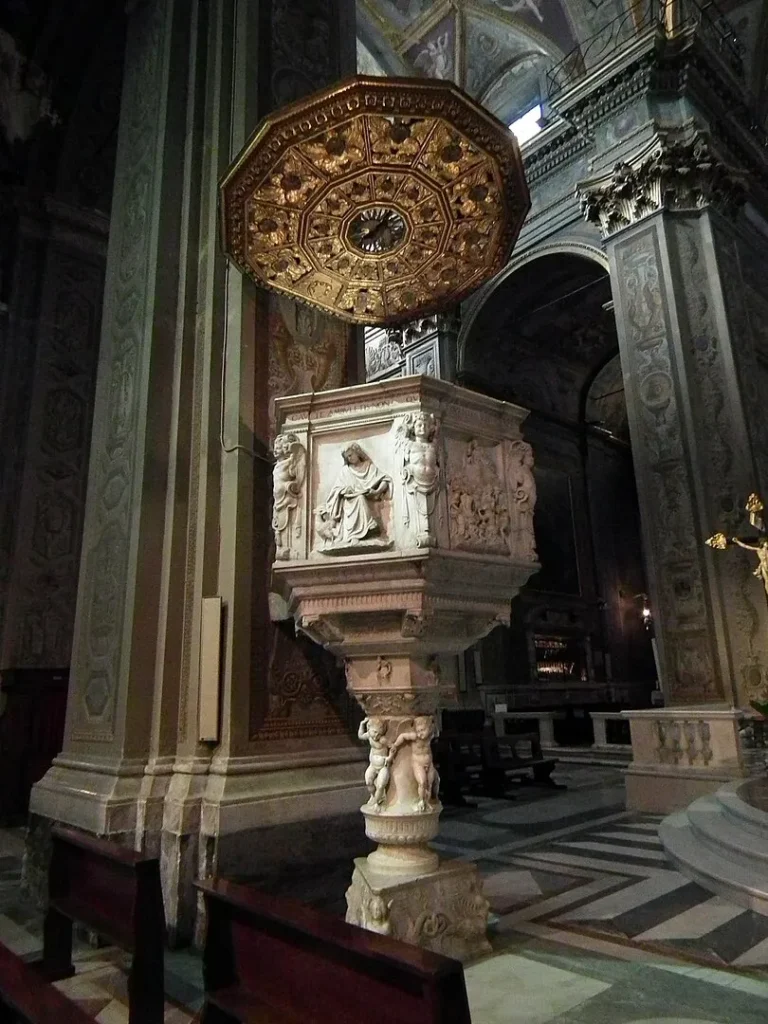
One of the most treasured elements within the cathedral is the pulpit, which originally came from the ancient cathedral. Situated at the head of the nave against the left pillar, this pulpit is a Renaissance sculpture crafted from marble. It takes the form of a chalice with a hexagonal case that is open on one side. The pulpit is adorned with five intricate reliefs, each separated by angelic herms. These reliefs depict the four Evangelists, each seated on a rocky base with their corresponding symbols. In the center of the pulpit, Saint Paul is shown preaching to a crowd, bringing life and movement to the sculpture.
Below the reliefs of the Evangelists, a series of smaller relief figures of saints, including Saint Peter, Saint John the Baptist, Saint Jerome, Saint Gregory the Great, Saint Augustine, and Saint Ambrose, are carved into the marble. The base of the pulpit is triangular, supported by three winged sirens, with four putti (cherubic figures) adding a playful and delicate touch to the composition.
This remarkable pulpit was created between 1521 and 1525 by the Lombard sculptors Antonio Maria Aprile and Giovanni Angelo Molinari, reflecting the skilled craftsmanship of the Renaissance period and the profound religious themes that dominate the cathedral’s decoration.
Wooden Choir
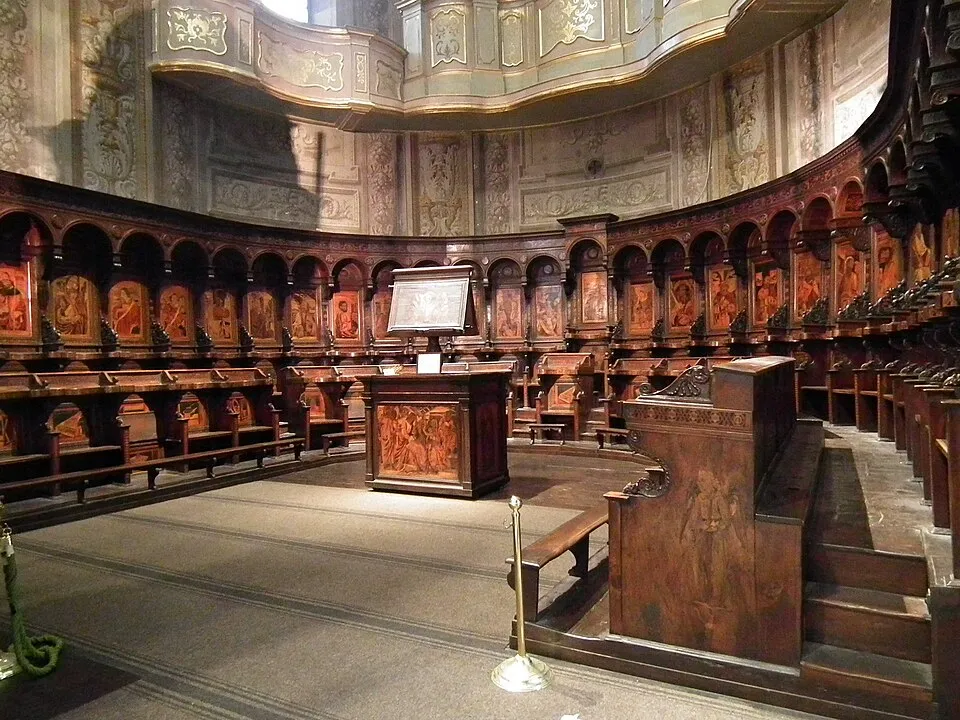
A remarkable feature of the Savona Cathedral is the intricate inlaid wooden choir stalls, which were crafted between 1500 and 1521 for the original Gothic cathedral and later adapted for the new one. These stalls were commissioned by Giuliano Della Rovere, who was then the cardinal of S. Pietro in Vincoli and bishop of Savona. Giuliano, who would later ascend to the papacy as Pope Julius II, desired to be depicted in the inlay. The choir is made up of 37 upper stalls and 21 front stalls. The upper stalls are characterized by dossals featuring full-length busts of saints, each topped with a lunette canopy supported by brackets and a decorative frieze. The stalls are divided by pilasters adorned with detailed candelabra motifs. The front stalls are simpler, consisting of a postern and an underseat, with inlaid decorations showcasing still life scenes, including sacred furnishings, liturgical books, animals, and fruit, in keeping with the Renaissance tradition of 15th-century inlay.
The creation of the choir was funded by an initial 1132 gold ducats, divided equally between the Republic of Savona and Giuliano della Rovere. The execution was entrusted to Anselmo de Fornari from Castelnuovo Scrivia and Elia Rocchi, who completed the project by 1514 under the direction of Fornari. Fornari’s signatures, “Anselmus” and “Ans. For.” can still be found on the sides of the stalls. The finishing touches were made by Gian Michele Pantaleoni from Serravalle Scrivia, who crafted additional panels that served as the backrests for the stalls. Pantaleoni also created access doors adorned with an inlaid Nativity scene—these doors originally served the chapel of the Madonna della Colonna. Additionally, Pantaleoni crafted a lectern in 1517, featuring two inlays with cherubs holding the coats of arms of Savona and the Della Rovere family. The inlays by Pantaleoni were created using a technique of pyrography, in which the wood was burned to achieve more refined and pictorial effects. Some altarpieces are also attributed to Pantaleoni, including a depiction of Saint Barnabas and a particularly refined altarpiece in the center of the choir showing the Madonna holding the Baby Jesus with Julius II receiving the keys of papal power. The powerful figures and flowing drapery in this artwork echo the influence of Raphael.
The choir was restored twice, first by the Garassino brothers in 1862, who also added inlaid decorations to the access doors to the sacristy and bell tower. A comprehensive restoration took place between 2002 and 2003.
Side Chapels of Savona Cathedral
The side chapels of the Cathedral of Savona hold a rich history and a variety of significant artworks. On the right side aisle, several chapels feature remarkable pieces. The first chapel displays “The Apparition of the Virgin in Savona” by Ratti. The second chapel features the “Sacred Heart” by Paolo Gerolamo Brusco, while the third chapel holds the “Madonna with Child and Angels,” as well as scenes from “Jacob’s Dream” by Giovanni Baglione and “Abraham with Angels” by Giovanni Lanfranco. Below this aisle is a door leading to the cloister, surmounted by a gilded wooden tribune from which Pope Pius VII observed religious functions during his imprisonment in Savona from 1809 to 1812, imposed by Napoleon. The fourth chapel contains the monument to Bishop Righetti, designed by Renata Cuneo. In the transept chapel, a 17th-century altar dedicated to the deceased takes prominence, while a sixteenth-century altarpiece and funerary monuments of prelates adorn the chapel to the right of the presbytery.
On the left side aisle, the chapels also feature significant works. In the first chapel, a 17th-century altarpiece depicting Saint Francis of Paola is accompanied by frescoes by Brusco. The second chapel holds an altarpiece of the “Adoration of the Magi” by Bernardo Castello, while the third chapel showcases the “Martyrdom of Saint Ursula” by Giovanni Battista Paggi. Continuing along the aisle is the side door, topped by the 14th-century tympanum of the ancient cathedral. The remaining chapels on both sides hold even more evocative significance due to their connection to miraculous events. The fourth chapel, which holds the “Madonna della Colonna,” contains a medieval fresco from around 1430-1440. This image of the Madonna is said to have miraculously detached itself from a column of the old Church of San Francesco in 1601 when the building was being demolished. The chapel features seventeenth-century altarpieces, such as “The Presentation of Mary in the Temple” and “The Annunciation,” along with stories from the life of Mary depicted on the vault. Additionally, on either side of the Madonna, there are altarpieces of Saint Ambrose and Saint Bernard.
In the fifth chapel of the transept, the Baroque altar (1663) dedicated to the Madonna of Mercy was transferred here in 1870 from the demolished Convent of the Discalced Carmelites of Santa Teresa. In the center of this altar stands the statue of Our Lady of Mercy, with Antonio Botta kneeling before her. Created in 1625 by Stefano Sormano, the statue commemorates the apparition of the Virgin to a peasant named Antonio Botta on the heights of Savona in 1536. The frescoes on the ceiling are from the seventeenth century, while the statues of St. Joseph with Child and St. John the Evangelist, along with the nineteenth-century canvases on the side walls depicting the Redeemer blessing the children and the adulteress, were added later. The chapel to the left of the presbytery is dedicated to the Blessed Sacrament and displays the urn containing the skeleton of Blessed Ottaviano, the Bishop of Savona, who is said to have saved the population from the plague and predicted the apparition of Mary. The chapel features canvases from the 17th and 18th centuries, including one from the Roman school depicting the “Martyrdom of Saint Stephen.” Finally, the cathedral is also home to relics of Saint Valentine, the Martyr and patron saint of lovers.
Pipe Organ
Behind the main altar and above the wooden choir stalls is the Mascioni Opus 476 pipe organ, which was constructed in 1935. The organ is housed within the case of an earlier 18th-century instrument. It features an electric transmission system and has three keyboards of 61 notes each, as well as a concave-radial pedalboard with 32 notes. The organ’s sound adds to the grandeur of the cathedral, making it an essential part of its musical heritage.
Feast Day
Feast Day: 15 August
The feast day of the Cathedral of Our Lady of the Assumption in Savona, Italy, is celebrated on August 15th. This date coincides with the Feast of the Assumption of the Blessed Virgin Mary, a major feast in the Catholic liturgical calendar that celebrates the belief that Mary was assumed into heaven, body and soul.
Church Mass Timing
Monday : 8:00 AM
Tuesday : 8:00 AM
Wednesday : 8:00 AM
Thursday : 8:00 AM
Friday : 8:00 AM
Saturday : 8:00 AM and 6:00 PM
Sunday : 10:30 AM and 6:00 PM
Church Opening Time:
Monday : 10:00 am – 12:45 pm – 3:30 pm – 5:45 pm.
Tuesday : 10:00 am – 12:45 pm – 3:30 pm – 5:45 pm.
Wednesday : 10:00 am – 12:45 pm – 3:30 pm – 5:45 pm.
Thursday : 10:00 am – 12:45 pm – 3:30 pm – 5:45 pm.
Friday : 10:00 am – 12:45 pm – 3:30 pm – 5:45 pm.
Saturday : 10:00 am – 12:45 pm – 3:30 pm – 5:45 pm.
Sunday : 10:00 am – 12:45 pm – 3:30 pm – 5:45 pm.
Contact Info
Address :
Via Ambrogio Aonzo, 7R, 17100 Savona SV, Italy.
Phone : +39019825960
Accommodations
Connectivities
Airway
Cathedral of Our Lady of the Assumption, Savona, Italy, to St. Paul Heliport distance between 9 min (3.4 km) via SS 1.
Railway
Cathedral of Our Lady of the Assumption, Savona, Italy, to Savona Railway Station Savona, distance between 7 min (2.1 km) via P.za Aldo Moro.

